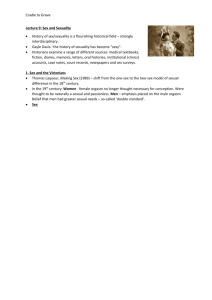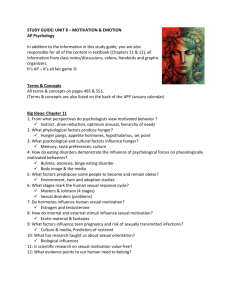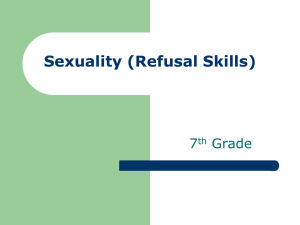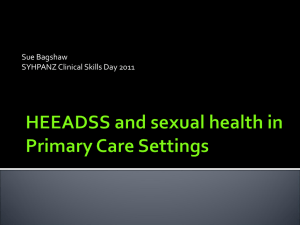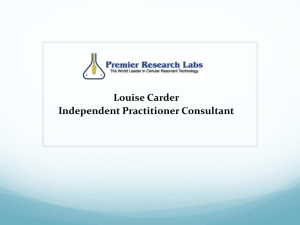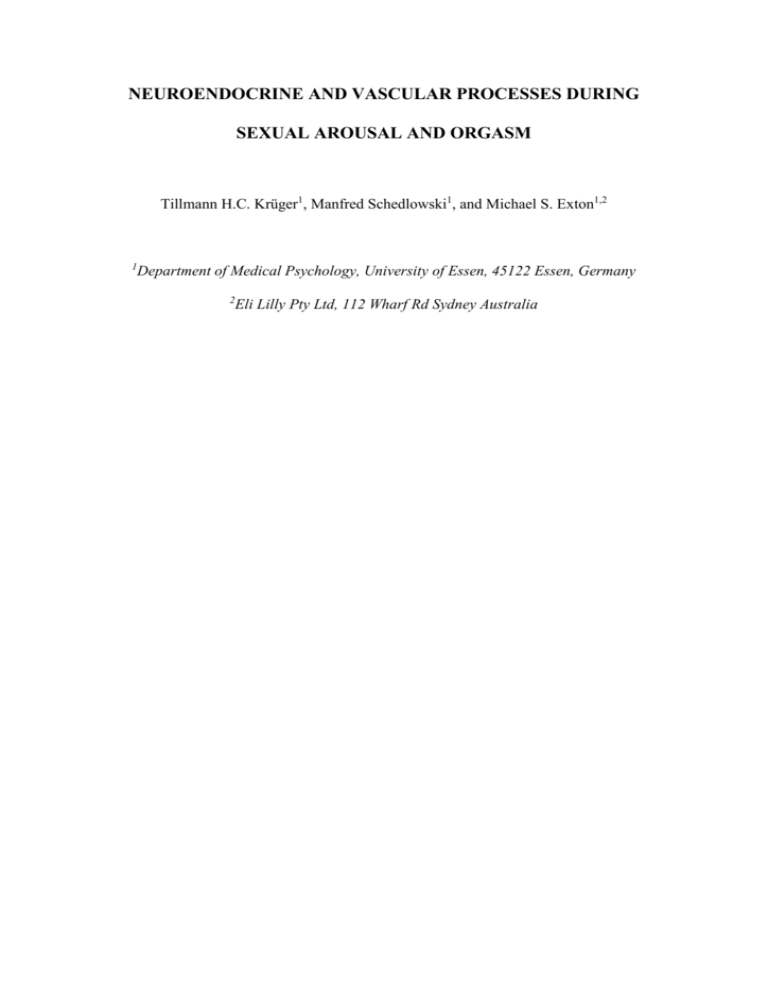
NEUROENDOCRINE AND VASCULAR PROCESSES DURING
SEXUAL AROUSAL AND ORGASM
Tillmann H.C. Krüger1, Manfred Schedlowski1, and Michael S. Exton1,2
1
Department of Medical Psychology, University of Essen, 45122 Essen, Germany
2
Eli Lilly Pty Ltd, 112 Wharf Rd Sydney Australia
2
ABSTRACT
A series of studies in our laboratory have reliably demonstrated that plasma prolactin (PRL)
concentrations are substantially increased for over an hour following orgasm in both men and
women, but unchanged following sexual arousal without orgasm. As chronic elevations of
PRL (hyperprolactinemia) reduce sexual activity and functions, we propose that the PRL
response to orgasm may play an important role in regulating post-orgasmic sexual drive, as a
peripheral regulatory factor for reproductive function, and/or a feedback mechanism that
signals CNS centres controlling sexual arousal and behaviour. Current studies are being
undertaken to test this hypothesis.
3
NEUROENDOCRINE RESPONSE TO ACUTE SEXUAL AROUSAL
Despite investigation now spanning well over 30 years, little consensus has been reached
regarding the endocrine control of sexual arousal in healthy humans.
Historically, the
approach to this question has been to measure the endocrine response to various modes of
sexual stimulation.
This undertaking allows an examination of hormones that may be
involved in the up- or down-regulation of a sexual response, depending on the timing and
magnitude of such changes. The numerous studies that have spanned over three decades of
research have shown a high level of agreement in regard to cardiovascular responses to sexual
activity (Carminchael et al., 1994; Nemec et al., 1976; Whipple et al., 1992; Littler et al.,
1974), but in contrast, a remarkable lack of consistency in regard to sympathetic, pituitary and
gonadal hormones been notable for lack of consistency in conclusions made between studies
(Levi, 1969; Wiedeking, 1977; Carani et al., 1990; Purvis et al., 1976; Brown et al., 1975;
Rowland et al., 1987; La ferla et al., 1978; Stoleru et al., 1993; Lee et al., 1974; Lincoln,
1974; Pirke et al., 1974; Fox et al., 1972; Heiman et al., 1991; Blaicher et al., 1999;
Carmichael et al., 1994; 10- 20). Nevertheless, we must be cognisant that technical advances,
combined with a number of very different methodological approaches, contribute significantly
to the variance between data from different experiments.
INCONSISTENT METHODOLOGY
Studies examining the neuroendocrine response to sexual arousal and orgasm have employed
many different methodologies, thus making general interpretations difficult. One potential
confound amongst studies is the contrasting methods employed for the induction of sexual
arousal. Researchers have employed the viewing of stimulating films, imagery of fantasies,
masturbation, and coitus. These methods clearly demonstrate different characteristics of
sexual stimulation, with differences in duration and intensity of exposure, as well as the
4
amount of physical contact.
Additionally, differences between such studies are further
compounded by some studies requesting participants to achieve orgasm, whilst others did not.
Together, such factors have contributed to the inability to directly compare data generated
from different laboratories.
Additionally, a primary concern limiting the evaluation of results from these studies is the
method of blood collection. Blood has often been sampled at single discrete time points,
sometimes with the experimenter entering the experimental room. Such a methodology has a
number of potential deficits.
Firstly, short-term alterations of certain neuroendocrine
variables may be missed by using this technique. Secondly, entering the experimental room
may cause the participant undue concern that may potentially contribute to any observed
endocrine alterations. Thirdly, punctual blood sampling may induce physical discomfort that
may also impact hormonal status.
Therefore, we designed a method for the examination of the neuroendocrine response to
sexual arousal and orgasm in healthy males and females (Krüger et al., 1998; Exton et al.,
1999; 2000; 2001). We established this paradigm so as to eliminate difficulties due to
punctual blood sampling, as well as the influence of the presence of the experimenter. By
keeping these factors constant we are able to compare factors that are incomparable in the
literature – namely the effect of different modes of stimulation, as well as the influence of
orgasm on endocrine alterations following sexual arousal.
IMPROVED METHODOLOGY
For the examination of the endocrine response to sexual arousal and orgasm we developed a
laboratory model of continuous blood sampling that we formerly established in experimental
field studies. Most experiments were conducted in ten healthy male or female volunteers.
5
Each experiment was conducted in participants naïve to the experimental conditions. All
subjects were exclusively heterosexual, and reported a relaxed attitude towards masturbation
and pornography. All volunteers underwent an intensive non-structured clinical interview to
exclude participants with confounding physical or mental health problems. Subjects with
drug or alcohol abuse, medication intake, or sexual dysfunctions were excluded from
participation. Volunteers were requested to refrain from any kind of sexual activity and to
avoid alcoholic beverages or other drugs 24 h prior to the laboratory investigation. The study
paradigm is displayed in Figure 1. A balanced cross-over design was implemented, involving
two sessions on consecutive days, with each session commencing at 15:00 h. Subjects laid on
a comfortable bed in front of a video screen, with the head propped by pillows to allow
viewing of the video. In the control session volunteers viewed a neutral documentary video,
whilst the experimental session was composed of three video sequences, each lasting 20 min.
The first and last sections of this tape were composed of the identical documentary film. The
middle 20 min of the experimental video was a pornographic film that showed different
heterosexual couples having sexual intercourse.
To ensure accuracy of measurements and privacy of the participants, our method of
continuous blood withdrawal was achieved by the use of a small portable pump.
An
intravenous cannula was inserted into a brachial vein, and then connected to heparinised
silicon tubing that passed through the test room wall into the adjoining room. The use of the
minipump allowed adjustment of blood flow, which was typically 1-2 ml/min. Blood was
collected into EDTA tubes, which allows variation of the time period of each collection,
simply via replacing the tubes. For the current set of experiments we changed tubes every 10
min to allow a time kinetic of endocrine variables. Samples were centrifuged at 4°C and
plasma stored at -70°C until assayed.
6
By using the method of blood collection we established an accurate paradigm of measuring
hormone concentrations over a period of sexual arousal. This allowed a comparison of
various methods for inducing sexual arousal on hormone concentrations, and furthermore, the
impact of orgasm on these responses. Thus, we completed three sets of experiments in both
males and females, altering the stimulation paradigm:
1. Following 10 min viewing of the pornographic video (anticipatory phase), subjects in the
experimental session were asked to masturbate until orgasm.
2. Following 10 min viewing of the pornographic video, subjects in the experimental session
were asked to have coitus until orgasm. Heterosexual couples participated in this experiment.
In this paradigm, subjects who were being examined for endocrine changes laid comfortably
on the bed, whilst all the movement was conducted by the partner. This reduced any changes
in hormone concentrations that may have been due to movement, allowing direct examination
of the specific neuroendocrine response to sexual arousal and orgasm.
3. Subjects in the experimental session watched the pornographic film for 20 min, but did not
masturbate to orgasm.
ENDOCRINE RESPONSE TO ORGASM: PROLACTIN MAY BE A REGULATOR
OF POST-ORGAMIC SEXUAL DRIVE
In our laboratory, sexual stimulation consistently produced high levels of subjective sexual
arousal, as assessed by visual-analogue scale. Furthermore, this result was corroborated by
objective measurements of sexual arousal in females, using vaginal photoplethysmography.
These data give face validity to our endocrine measurements, as they reflect hormonal changes
that would occur in “real world” sexual situations.
7
Measurement of cardiovascular responses and sympathetic hormones also demonstrate a
consistent response to sexual arousal and orgasm, increasing heart rate, blood pressure,
adrenaline and noradrenaline, which return rapidly to control levels after orgasm. Further
consistent responses were observed in cortisol, FSH, LH, testosterone, -endorphin,
progesterone and estradiol: orgasm produced no reliable alteration of these hormones.
In contrast, PRL was shown to be consistently and specifically altered by orgasm in both
males and females. Figure 2 demonstrates the PRL response to various forms of sexual
arousal in both genders. Across all experiments, no changes in PRL were observed during the
first 20 minutes of documentary film. Furthermore, no changes of any significance were
observed following the first 10 minutes of pornographic film viewing.
However, the
generation of orgasm via either self-masturbation or coitus produced pronounced increases in
PRL concentrations in peripheral circulation of both males and females. Additionally, these
alterations remained significantly elevated 60 minutes following orgasm. Furthermore, the
PRL response is clearly specific to orgasm, as sexual arousal alone (both film and
masturbation without orgasm) induced no changes of PRL in either males or females. This
was confirmed in a recent study where we employed a 2-minute blood sampling interval
(Krüger et al., 2003). Interestingly, in this study, we observed for the first time in our
laboratory an orgasm-induced increase in oxytocin, although this was small and nonsignificant. As this hormone has been considered a responsive hormone to sexual arousal and
orgasm, these data support the significance of the pronounced and long-lasting impact of
orgasm on PRL. Indeed, together the data suggest that PRL may play a role in the acute
regulation of further sexual arousal and/or reproductive functions following orgasm.
DOES PROLACTIN REGULATE SEXUAL FUNCTION AND BEHAVIOUR?
8
Support from Physiology
The physiological role of the pituitary peptide hormone PRL contributes to the feasibility that
it may be involved in the acute regulation of sexual drive. Indeed, although PRL was
considered initially to be a mechanism of lactation (Stricker & Greuter, 1928), it has broad
physiological importance, being ascribed over 300 biological functions (Bole-Feysot et al.,
1998). Unlike most most pituitary hormones whose release is triggered by specific releasing
hormones from the hypothalamus, PRL is under tonic inhibitory control by the hypothalamus.
Of particular importance to PRL control of sexual function is that the primary inhibitory input
is dopamine (Maruyama et al., 1999), a neurotransmitter that is intimately involved in the
regulation of sexual drive and behaviour.
That PRL may be involved in regulation of sexual drive is underscored by the expression of
the PRL receptor within CNS structures that are known to regulate sexual behaviour.
Specifically, PRL receptors are located in the hippocampus, cortex, amygdala and various
hypothalamic nuclei (Roky et al., 1996; Pi et al., 1999a; 1999b). In addition, PRL receptors
have been characterised within both male and female reproductive organs. In addition to the
mammary gland, PRL receptors are located in females in the ovary and uterus, and in males in
the testis, epididymis, and prostate (Yoshimura et al., 1992; Prigent-Tressier et al., 1996;
Howell Skala et al., 2000; Reddy et al., 1985; Perez-Villamil et al., 1980).
Clinical support
Key to the theory that acute PRL may regulate acute sexual drive is an extrapolation from
extensive animal and clinical evidence of the impact of chronic elevations of PRL
(hyperprolactinemia) on sexual behaviour and function. Animal data consistently
demonstrates that hyperprolactinemia impairs sexual function on both motivational and
9
physiological levels in the male (increased latency to mounting and ejaculation, decreased
frequency of mounts, intromissions, and ejaculations) and female rat (lordosis behaviour)
(Doherty et al., 1990; 1985; 1986; 1985; Kooy et al., 1988).
This animal evidence is well supported clinically. Hyperprolactinemia commonly occurs
during pregnancy and lactation.
Additionally, hyperprolactinemia may be produced by
pathological mechanisms, such as prolactinoma, para- and suprasellar tumours affecting
hypothalamic PRL regulatory factors, “empty sella”-syndrome, severe primary hypothyreosis
and chronic renal failure. The development of a prolactinoma, an adenoma of pituitary
lactotrophs, is one of the most common reasons for hyperprolactinemia.
Hyperprolactinemia is associated with pronounced reductions of both sexual motivation and
function. Elevated levels of PRL inhibit GnRH pulsatility (Sauder et al., 1984) and thus low
gonadotropin production, amenorrhoea, gynaecomastia and galactorrhoea in some women. In
men hyperprolactinemia is commonly associated with low testosterone levels and
oligospermia (Buvat et al., 1985; Walsh and Pullan, 1997; Sobrinho, 1993). Although some
experimental evidence suggests that hyperprolactinemia suppresses physiological reproductive
functions whilst maintaining sexual drive (Carani et al., 1996), other studies clearly indicate
that chronic PRL elevation also negatively impact upon sexual libido (Koppelman et al.,
1987). This has been particularly observed in clinical psychopharmacology.
For example, new generation of antidepressants such as Selective-Serotonin-ReuptakeInhibitors (SSRIs) produce hyperprolactinemia (Rosen et al., 1999). The increased PRL
secretion induced by this medication is associated with dramatically reduced sexual appetence
and delayed ejaculation in men (Rosen et al., 1995; Waldiger et al., 1998). In women
10
symptoms range from decreased sexual drive to orgasmic disturbances such as anorgasmia
and delayed orgasm (Shen et al., 1995; Montejo-Gonzalez et al., 1997). Further, typical
neuroleptics, and some atypicals, used to treat schizophrenia, produce a strong elevation of
plasma PRL. Hyperprolactinemia is associated with loss of libido, erectile dysfunction and
anorgasmia, with this effect not observed with atypical neuroleptics that do not elevate PRL
(eg olanzapine).
Underscoring the importance of PRL in regulating sexual function, dopaminergic agonists
have become a common approach to the treatment of hyperprolactinemia. Recently, the first
commonly utilised dopaminergic agonist bromocriptine has been replaced by cabergoline,
which produces striking normalisation of hyperprolactinemia (Verhelst et al., 1999). Indeed,
carbergoline has recently been shown in a number of large studies to normalise PRL levels
and thereby restore libido and gonadal function in hyperprolactinemic patients (De Rosa et al.,
1998).
Together, these data suggest a strong association between chronic elevations of PRL and
marked suppression of both sexual drive and gonadal functions. This raises the possibility
that acute elevations of PRL following orgasm may play a role in the regulation of sexual
arousal and function. Indeed, some evidence suggests that this hormone may play an integral
role in acute regulation of sexual behaviour.
COMPARING
APPLES
WITH
APPLES:
IMPLICATIONS
OF
HYPERPROLACTINEMIA FOR PRL RELEASE FOLLOWING ORGASM
While the effects of chronic elevations of PRL on sexual drive and reproductive function are
well described, the relevance of acute changes in PRL for sexual activity is equivocal. This
11
raises the question of whether it is feasible to extrapolate the well-known effects of chronic
prolactin elevation to acute changes. Indeed, animal models have demonstrated that acute
increases in peripheral PRL, particularly at levels that are in the normal physiological range
(e.g. 50ng/ml), stimulate the sexual behaviour of male rats (Drago and Dissandrello, 2000). In
contrast, other reports have demonstrated that acute increases of peripheral PRL increase,
decrease, or have no effect on rat sexual behaviour (Cruz-Cassalas et al., 1999; Nasello et al.,
1997).
Thus, the biological effects of acute increases in PRL on sexual behaviour are unclear.
Nevertheless, some evidence suggests that orgasm-induced PRL secretion may contribute to
the acute regulation of sexual arousal and reproductive function. Indeed, acute elevations of
this peptide may have both peripheral and central consequences for sexual function and
arousal.
Peripheral actions
In addition to the well characterised impact of PRL in regulating reprodtive functions such as
spermatocyte-spermatid conversion in germ cells, enhanced energy metabolism in
spermatozoa, transport of ejaculated and epididymal spermatozoa, formation and destruction
of the corpus luteum, uterine endometrial development and blastocyst implantation (BoleFeysot et al., 1998; Outhit et al., 1993), some evidence suggests that acute PRL may impact
sexual functions. Specifically, in males, the acute release of PRL following orgasm may
impact sexual behaviour via direct action on the penile tissue. Although not extensively
examined, some data clearly demonstrate that acute increases in PRL inhibit erectile function
via inhibition of smooth muscle relaxation of the corpus cavernosum (Aoki et al., 1995; Ra et
al., 1996). This suggests that an acute increase in PRL levels may participate in penile
12
detumescence. However, our data showing that acute increases in PRL remain over 60
minutes following orgasm suggest a complex interaction of this hormone with neural
regulation of erection. It is plausible that initial PRL increases may contribute to penile
detumescence, which is then reversed by other central and local factors. This would concur
with the known physiological regulation of erection, which represents a balance between
different neural and endocrine inputs at multiple levels (Andersson and Wagner, 1995).
Indeed, the effects of PRL are likely to interact both with other neuroendocrine factors as well
as behavioural variables, as drugs inhibiting basal PRL have been shown not to alter erectile
functions in impotent males (March, 1979; Cooper, 1977). However, it must be noted that the
expression of PRL receptors in the corpus cavernosum has yet to be demonstrated.
Thus, these data show that in contrast to the negative impact of hyperprolactinemia on
fertility, the acute increase in PRL following orgasm in males and females may contribute to
an environment that ensures successful conception. However, the acute increase of PRL may
also provide a feedback signal to nuclei in the central nervous system controlling both
peripheral reproductive functions as well as centres involved in the regulation of sexual drive.
Central actions
The three major dopaminergic networks in the CNS may form the primary targets for
peripheral PRL feedback. These networks are firstly, the neuroendocrine hypothalamic and
incerto-hypothalamic
neurons
(diencephalic;
DC),
secondly,
the
mesolimbocortical
dopaminergic neurons (MLC), and finally, the nigrostriatal dopamine system (NS). Together,
these systems are recognised as playing a major role in modulating sexual motivation,
behaviour, and function, with both sensory stimulation and copulation producing
dopaminergic activity in all three systems (Hull et al., 1999; Mas, 1995). The central role of
13
dopamine in regulating sexual activity is underscored by the pronounced impact of
dopaminergic drugs on both animal and human sexual function (Bancroft, 1999; Meston and
Frohlich, 2000). Thus, these systems present as primary targets for PRL feedback to the CNS,
and some evidence indeed suggests that the activity of each system is modified by PRL.
The most recognised pathway of PRL feedback to the CNS is to hypothalamic neuroendocrine
neurons. Three populations of hypothalamic dopaminergic neurons regulate PRL release (De
Maria et al., 1998; 1999): Tuberoinfundibular dopaminergic neurons (TIDA) originating in
the arcuate nucleus (ARN) and terminating in the median eminence (ME) (Fuxe, 1964);
tuberohypophyseal dopaminergic neurons (THDA) extending from the rostral ARN and
terminating in the intermediate (IL) and neural (NL) lobes of the pituitary gland (Bjorklund et
al., 1973); and periventricular-hypophyseal dopaminergic neurons arising in the hypothalamic
periventricular nucleus (PeVN) and terminating exclusively in the IL (Goudreau, 1992). These
neurons express PRL receptors (Freeman et al., 2000), thus providing the prerequisites for a
feedback loop by peripheral PRL. Although PRL is not able to pass the blood-brain-barrier it
can be secreted by the choroids plexus into the cerebrospinal fluid or passes the area postrema
and subsequently reach the brain tissue (Sobrinho, 1993). The capacity of PRL to reach the
CNS is shown by a series of studies demonstrating that subcutaneously administered ovine
PRL activates all three populations of hypothalamic dopaminergic neurons. Importantly, this
effect occurred within one hour, thus contradicting the notion that peripheral PRL requires up
to five days to reach optimal brain concentrations by active transport mechanisms (Walsh et
al., 1987). Thus, PRL forms a negative feedback loop to control its own release, similar to
pathways observed for many other pituitary hormones.
14
In addition to feedback on neurons controlling its own secretion, PRL also may feedback to
dopaminergic systems that have been implicated in controlling sexual arousal. Specifically,
animal studies have revealed three (main) integrative dopaminergic systems primarily
responsible for the control and modulation of sexual behaviour. First, the incertohypothalamic dopaminergic system which projects to the medial preoptic area (MPOA) is
identified as one of the most important areas for the control of motivational and
consummatory aspects of sexual behaviour. Specifically, the generation of genital reflexes
required for erection and ejaculation, the focussing of male attention on sexually relevant
stimuli, and the increase of species-specific motor patterns during copulation are controlled by
the MPOA. Importantly, the PRL receptor is strongly expressed in the MPOA (Pi et al.,
1998), with increased PRL decreasing the dopaminergic activity of the MPOA (Lookingland
and Moore, 1984). Although no data exists showing the PRL-induced inhibition of MPOA
activity reduces sexual drive, PRL has been demonstrated to inhibit maternal behaviours also
driven by dopaminergic MPOA activity (Brodges et al., 2001). Thus, peripheral PRL is
clearly capable of modifying the dopaminergic activity of the MPOA, and indeed appears to
act as a negative feedback mechanism.
The mesolimbocortical dopaminergic system (MLC), which originates in the ventral
tegmental area and projects to the mesial components of the limbic system (e.g. nucleus
accumbens, amygdala, mesial frontal cortex), is the second potential target of PRL feedback.
Similar to its role in reward processes, the dopaminergic output of the MLC is primarily
responsible for appetitive/motivational regulation of sexual activity. This is evidenced by
stimulation of MLC dopamine in response to sexually related sensory stimuli (Bradley and
Meisel, 2001; Fiorino et al., 1997). Similar to the MPOA, dopaminergic activity of the
nucleus accumbens and limbic forebrain is antagonised by acute peripheral or central PRL
15
administration (Gonzales-Mora et al., 1990; Chen and Ramirez, 1988). In contrast, other
reports have demonstrated increased MLC dopaminergic activity following direct PRL
infusion in the nucleus accumbens (Hernandez et al., 1994). These contrasting data are likely
to be attributable to differentially PRL concentrations, resulting from the route of
administration.
Nevertheless, these data clearly demonstrate a mechanism whereby
peripherally secreted PRL may feedback to modify MLC dopaminergic control of sexual
motivation.
In addition, the nigrostriatal dopaminergic system (NS), which originates in the substantia
nigra and projects primarily to the putamen and caudate nucleus, is a candidate for a feedback
mechanism of PRL. The NS is proposed to integrate both sensory and motor aspects of sexual
behaviour, with NS dopamine enabling a state of ‘preparedness’. Dopaminergic activity of
the NS thus contributes to generation of consummatory motor functions, such as the pursuit of
a sexual partner before copulation (Robbins and Everitt, 1992). PRL is clearly capable of
modifying dopaminergic activity within the NS. Acute central and peripheral administration
of PRL modifies the activity of dopaminergic neurons in the striatum, with both excitatory
and inhibitory effects noted (Chen and Ramirez, 1989; Cebeira et al., 1991). Furthermore,
dopamine production by superfused slices of striatum in vitro is stimulated by PRL (Chen and
Ramirez, 1988). Indeed, stimulation of striatal dopamine output by acute PRL administration
has been demonstrated to be associated with facilitation of sexual behaviour in the male rat
(Cruz-Casallas et al., 1989). Thus, dopaminergic activity of NS is clearly influenced by
peripheral PRL, and associated with altered sexual behaviour.
A MODEL OF PRL REGULATION OF SEXUAL FUNCTION FOLLOWING
ORGASM
16
We have argued that the weight of data suggests that PRL may be an endocrine regulator of
human sexual behaviour, which is integrated with neural control of sexual function. The
pathways whereby PRL may fill this role is schematically displayed in Figure 3. PRL may
impact upon peripheral reproductive organs to either facilitate physiological mechanisms
essential for successful conception and/or inhibit further reproductive activity. Alternatively,
PRL may form a feedback mechanism to the CNS, modifying the activity of DC, MLC and
NS dopaminergic neurons.
As no direct experimental evidence exists demonstrating a feedback role of PRL in
modulating sexual arousal and function, extrapolations have clearly been made in proposing
the current model. First, although chronic hyperprolactinemia is related to the suppression of
both reproductive function and sexual arousal, this is commonly characterised by PRL levels
>200 ng/ml, which are experienced over a number of months. In contrast, PRL levels are
increased following orgasm to levels between 15 and 25 ng/ml for at least an hour, although
the exact duration of this effect in unknown.
Thus, the marked inhibitory effect of
hyperprolactinemia cannot be directly inferred to occur following acute PRL increases.
Nevertheless, data from animal experiments suggest that acute PRL administration, in levels
that we observe following orgasm, may produce meaningful modification of sexual behaviour
as well as alterations of central and peripheral systems responsible for sexual drive and
reproductive function. Nevertheless, the only way to confirm this position experimentally is
to manipulate PRL levels acutely in healthy humans, and examine the impact of this on sexual
arousal and behaviour. We have recently completed the first experiment of this kind in our
laboratory, with data indicating that pharmacological manipulation of comparatively small
changes in PRL increases is sufficient to produce significant changes in sexual drive. Clearly
17
however, further investigation is required to elucidate the effect of acute increases in PRL for
human sexual arousal.
An important assumption in the current model is PRL access to the CNS. Certainly, although
the size of PRL does not allow it to cross the blood-brain-barrier (Walsh et al., 1978), it can
directly pass into the brain via the highly permeable circumventricular organs such as the area
postrema, subfornical organ and medien eminence (Ganong, 2000), all of which express PRL
receptors (Mangurain et al., 1999). Additionally, PRL may be indirectly transported into the
brain via cerebrospinal fluid Sobrinho, 1993). Thus, acute PRL is able to access brain tissue
via mechanisms that enable rapid transport. This suggests that rather than time-consuming
transport across the blood brain barrier by active transport, peripheral PRL can rapidly access
the CNS, supporting the role of this peptide in feedback to sites regulating sexual drive and
function. It is important however that we continue to examine the accessibility of PRL to the
CNS; ongoing studies in our laboratory are specifically examining CNS involvement in PRL
and functional changes following orgasm.
This model also assumes that PRL plays a role in regulating sexual drive and function in both
males and females, although the genders display distinct differences in sexuality, such as the
characteristics of the refractory period (Masters and Johnson, 1966). Nevertheless, although
the PRL response to orgasm is similar in both genders, it must be recognized that the effect of
this response is dependent upon a number of other factors, such as receptor expression and
sensitivity (Bole-Feysot et al., 1998). Accordingly, the PRL response may differ between the
genders according to impact upon peripheral and central regulation of sexual arousal and
function, thus potentially differentially regulating physical and psychological components of
18
the refractory period. Clearly, the specific consequences of acute PRL increases for both
genders clearly warrant further investigation.
A final assumption of this model is that the secretion of PRL is biologically relevant. In
contrast to this position, as PRL secretion is dopaminergically controlled, it is possible that it
rather represents a downstream effect of the well-known dopaminergic involvement in the
regulation of sexual behaviour.
Although possible, this position is counteracted by the
specificity of the dopaminergic control of sexual behaviour. The discrete secretion of PRL
following orgasm suggests a directed response that is not initiated during both sensory and
motor phases of sexual arousal.
Thus, it is unlikely that the PRL response represents
generalised dopaminergic activity during sexual encounters. Rather, the data suggest that the
PRL response represents a directed, biologically relevant response that is initiated by
inhibition of neuroendocrine dopaminergic neurons.
In summary, we have posited that the pituitary hormone PRL may represent an important
endocrine regulator of sexual drive and behaviour. As we proceed with examining the role of
PRL in post-orgasmic sexual drive, it is becoming clear that, while this hormone plays a role,
it is likely one among a constellation of neuroendocrine factors. An understanding of the
multiple physiological levels of human sexual behaviour represents a worthy challenge, with
the promise of an understanding of normal, pathological and psychopathological sexual
behaviour (Haake et al., 2003).
19
References
Andersson K-E, Wagner G. Physiology of penile erection. Physiol Rev 1995;75:191-236.
Aoki H, Fujioka T, Matsuzaka J, Kubo T, Nakamura K, Yasuda N. Suppression by prolactin
of the electrically induced erectile response through its direct effect on the corpus cavernosum
penis in the dog. J Urol 1995;154:595-600.
Bancroft J. 1999. Central inhibition of sexual response in the male: a theoretical perspective.
Neurosci Biobehav Rev 1999;23:763-784.
Bjorklund A, Moore RY, Nobin A, Stenevi U. The organization of tubero-hypophyseal and
reticulo-infundibular catecholamine neuron systems in the rat brain. Brain Res 1973;51:171191.
Blaicher W, Gruber D, Bieglmayer C, Blaicher AM, Knogler W, Huber JC. The role of
oxytocin in relation to female sexual arousal. Gynecol Obstet Invest 1999;47:125-126.
Bole-Feysot C, Goffin V, Edery M, Binart N, Kelly PA. Prolactine (PRL) and its receptor:
actions, signal transduction pathways and phenotypes observed in PRL receptor knockout
mice Endocrine Rev 1998;19:225-268.
Bradley KC, Meisel RL. Sexual behavior induction of c-Fos in the nucleus accumbens and
amphetamine-stimulated locomotor activity are sensitized by previous sexual experience in
female Syrian hamsters. J Neurosci 2001;21:2123-2130.
Bridges R, Rigero B, Byrnes E, Yang L, Walker A. Central infusions of the recombinant
human prolactin receptor antagonist, S179D-PRL, delay the onset of maternal behavior in
steroid-primed, nulliparous female rats. Endocrinology 2001;142: 730-739.
Brown WA, Heninger G. Cortisol, growth hormone, free fatty acids, and experimentally
evoked affective arousal. Am J Psychol 1975;132:1172-1176.
Buvat J, Lemaire A, Buvat-Herbaut M, Fourlinnie JC, Racadot A, Fossati P.
Hyperprolactinemia and sexual function in men. Horm Res 1985;22:196-203.
Carani C, Bancroft J, Del Rio G, Granata ARM, Facchinetti F, Marrama P. The endocrine
effects of visual erotic stimuli in normal men. Psychoneuroendocrinology 1990;15:207-216.
Carani C, Granata ARM, Faustini Fustini M, Marrama P. Prolactin and testosterone: their
role in male sexual function Int J Androl 1996;19:48-54.
Carmichael MS, Warburton VL, Dixen J, Davidson JM. Relationships among cardiovascular,
muscular and oxytocin responses during human sexual arousal. Arch Sex Behav 1994;23:5979.
Carmichael MS, Humbert R, Dixen J, Palmisano G, Greenleaf W, Davidson JM. Plasma
oxytocin increases in the human sexual response. J Clin Endocrinol Metab 1987;64:27-31.
20
Carmichael MS, Warburton VL, Dixen J, Davidson JM. Relationships among cardiovascular,
muscular, and oxytocin responses during human sexual activity. Arch Sex Behav 1994;23:5979.
Cooper AJ. Bromocriptine in impotence. Lancet 1977;2:567.
Cruz-Casallas PE, Nasello AG, Hucke EE, Felicio LF. Dual modulation of male sexual
behavior in rats by central prolactin: relationship with in vivo striatal dopaminergic activity.
Psychoneuroendocrinology 1999;24:681-693.
DeMaria JE, Lerant AA, Freeman ME. Prolactin activates all three populations of
hypothalamic neuroendocrine dopaminergic neurons in ovariectomized rats. Brain Res
1999;837:236-241.
DeMaria JE, Livingstone JD, Freeman ME. Characterization of the dopaminergic input of the
pituitary gland throughout the estrous cycle of the rat. Neuroendocrinology 1998;67:377-383.
DeMaria JE, Zelena D, Vecsernyés M, Nagy GM, Freeman ME. The effect of
neurointermediate lobe denervation on hypothalamic neuroendocrine dopaminergic neurons,
Brain Res 1998;806:89-94.
De Rosa M, Colao A, Di Sarno A, Ferone D, Landi ML, Zarilli S, Paesano L, Merola B,
Lombardi G. Cabergoline treatment rapidly improves gonadal function in hyperprolactinemic
males: a comparison with bromocriptine Eur J Endocrinol 1998;138:286-293.
Doherty PC, Wu DE, Matt KS. Hyperprolactinemia preferentially inhibits erectile function in
adrenalectomized male rats. Life Sci 1990;47:141-148.
Doherty PC, Lane SJ, Pfeil KA, Morgan WW, Bartke A, Smith MS. Extra-hypothalamic
dopamine is not involved in the effects of hyperprolactinemia on male copulatory behavior.
Physiol Behav 1989;45:1101-1105.
Doherty PC, Baum MJ, Todd RB. Effects of chronic hyperprolactinemia on sexual arousal
and erectile function in male rats. Neuroendocrinology 1986;42:368-375.
Doherty PC, Bartke A, Smith MS, Davis SL. Increased serum prolactin levels mediate the
suppressive effects of ectopic pituitary grafts on copulatory behavior in male rats. Horm
Behav 1985;19:111-121.
Drago F, Lissandrello CO. The ‘low dose’ concept and the paradoxical effects of prolactin on
grooming and sexual behavior. Eur J Pharmacol 2000;405:131-137.
Exton MS, Bindert A, Krüger T, Scheller F, Hartmann U, Schedlowski M. Cardiovascular and
endocrine alterations after masturbation-induced orgasm in women. Psychosom Med
1999;61:280-289.
Exton NG, Truong TC, Exton MS, Wingenfeld SA, Leygraf N, Saller B, Hartmann U,
Schedlowski M. Neuroendocrine response to film-induced sexual arousal in men and women.
Psychoneuroendocrinology 2000;25:189-199.
21
Exton MS, Krüger THC, Koch M, Paulson E, Knapp W, Hartmann U, Schedlowski M.
Coitus-induced orgasm stimulated prolactin secretion in healthy subjects.
Psychoneuroendocrinology 2001;26:287-294.
Exton MS, Krüger THC, Bursch N, Knapp W, Schedlowski M, Hartmann U. Neuroendocrine
response to masturbation-induced orgasm following a 3-week sexual abstinence. World J Urol
2001;19:377-382.
Fox CA, Ismail AAA, Love DN, Kirkham KE, Loraine JA. Study on the relationship between
plasma testosterone levels and human sexual activity. J Endocrinol 1972;52:51-58.
Freeman ME, Kanyicska B, Lerant A, Nagy G. 2000. Prolactin: structure, function, and
regulation of secretion. Physiol Rev 2000;80:1523-1631.
Fuxe K. Cellular localization of monoamines in the median eminence and in the infundibular
stem of some mammals, Acta Physiol Scand 1964;58:383-384.
Goudreau JL, Lindley SE, Lookingland KJ, Moore KE. Evidence that hypothalamic
periventricular dopamine neurons innervate the intermediate lobe of the rat pituitary.
Neuroendocrinology 1992;56:100-105.
Haake P, Krüger THC, Exton MS, Giepen C, Hartmann U, Osterheider M, Flesch M, Janssen
O, Leygraf N, & Schedlowski M. Acute neuroendocrine response to sexual stimulation in
sexual offenders. Canadian Journal of Psychiatry, 2003;48: 265-271.
Heiman JR, Rowland DL, Hatch JP, Gladue BA. Psychophysiological and endocrine
responses to sexual arousal in women. Arch Sex Behav 1991;20:171-186.
Howell Skalla L, Bunick D, Bleck G, Nelson RA, Bahr JM. Cloning and sequence analysis of
the extracellular region of the polar bear (Ursus maritimus) luteinizing hormone receptor
(LHr), follicle stimulating hormone receptor (FSHr), and prolactin receptor (PRLr) genes and
their expression in the testis of the black bear (Ursus americanus). Mol Reprod Dev
2000;55:136-45.
Hull EM, Lorraine DS, Du J, Matuszewich L, Lumley LA, Putnam SK, Moses J. Hormoneneurotransmitter interactions in the control of sexual behavior. Behav Brain Res
1999;105:105-116.
Kooy A, Weber RF, Ooms MP, Vreeburg JT. Deterioration of male sexual behavior in rats by
the new prolactin-secreting tumor 7315b. Horm Behav 1988;22:351-361.
Koppelman MCS, Parry BL, Hamilton JA, Alagna SW, Loriaux DL. Effect of Bromocriptine
on affect and libido in hyperprolactinemia. Am J Psychiatry 1987;144:1037-1041.
Krüger T, Exton MS, Pawlak C, von zur Mühlen A, Hartmann U, Schedlowski M.
Neuroendocrine and cardiovascular response to sexual arousal and orgasm in men.
Psychoneuroendocrinology 1998;23:401-411.
22
Krueger THC, Haake P, Chereath D, Knapp W, Janssen OE, Exton MS, Hartmann U, &
Schedlowski M. Specificity of the neuroendocrine response to orgasm during sexual arousal
in men. Journal of Endocrinology 2003;177:57-64.
La Ferla J, Anderson D, Schalch D. Psychoendocrine response to sexual arousal in human
males. Psychosom Med 1978;40:166-172.
Lee R, Jaffe R, Midgley A. Lack of alteration of serum gonadotropins in men and women
following sexual intercourse. Am J Obst Gynecol 1974;120:985-987.
Levi L. Sympatho-adrenomedullary activity, diuresis, and emotional reactions during visual
sexual stimulation in human females and males. Psychosom Med 1969;31:251-268.
Lincoln, G. Luteinising hormone and testosterone in man. Nature 1974;252:232-233.
Littler WA, Honour AJ, Sleight P. Direct arterial pressure, heart rate and electrocardiogram
during human coitus. J Reprod Fert 1974;40:321-331.
Lookingland KJ, Moore KE. Effects of estradiol and prolactin on incertohypothalamic
dopaminergic neurons in the male rat. Brain Res 1984;323:83-91.
Macleod RM, Lehmeyer JE. Studies on the mechanism of the dopamine-mediated inhibition
of prolactin secretion. Endocrinology 1974;94:1077-1085.
March CM. Bromocriptine in the treatment of hypogonadism and male impotence. Drugs
1979;17:49-58.
Mas M. Neurobiological correlates of masculine sexual behavior. Neurosci Biobehav Rev
1995;19:261-277.
Meston CM, Frohlich PF. The neurobiology of sexual function. Arch Gen Psychiatry
2000;57:1012-1030.
Montejo-Gonzalez AL, Llorca G, Izquierdo JA, Ledesma A, Bousono M, Calcedo A,
Carrasco JL, Ciudad J, Daniel E, De la Gandara J, Derecho J, Franco M, Gomez MJ, Macias
JA, Martin T, Perez V, Sanchez JM, Sanchez S, Vicens E. SSRI-induced sexual dysfunction:
fluoxetine, paroxetine, sertraline, and fluvoxamine in a prospective, multicenter, and
descriptive clinical study of 344 patients. J Sex Marital Ther, 1997;23:176-194.
Nasello AG, Vanzeler ML, Madurieira EH, Felicio LF. Effects of acute and long term
domperidone treatment on prolactin and gonadal hormone levels and sexual behavior of male
and female rats. Pharmacol Biochem Behav 1997;58:1089-1094.
Nemec ED, Mansfield L, Kennedy JW. Heart rate and blood pressure during sexual activity
in normal males. Am Heart J 1976;92:274-277.
Pérez-Villamil B, Bordiu E, Puente-Cueva M. Involvement of physiological prolactin levels in
growth and prolactin receptor content of prostate-glands and testes in developing male rats. J
Endocrinol 1980;132:449-459.
23
Pi XJ, Grattan DR. Differential expression of the two forms of prolactin receptor mRNA
within microdissected hypothalamic nuclei of the rat. Brain Res Mol Brain Res 1998;59:1-12.
Pi XJ, Grattan DR. Increased expression of both short and long term forms of prolactin
receptor mRNA in hypothalamic nuclei of lactating rats. J Mol Endocrinol 1999;23:13-22.
Pi XJ, Grattan DR. Increased prolactin receptor immunoreactivity in the hypothalamus of
lactating rats. J Neuroendocrinol 1999;11:693-705.
Pirke K, Kockott G, Dittmar F. Psychosexual stimulation and plasma testosterone in man.
Arch Sex Behav 1974;3:577-584.
Prigent-Tessier A, Pageaux JF, Fayard JM, Lagarde M, Laugier C, Cohen H. Prolactin upregulates prostaglandin E2 production through increased expression of pancreatic-type
phospholipase A2 (type 1) and prostaglandin G/H synthase 2 in uterine cells. Mol Cell
Endocrinol 1996;122:101-108.
Purvis K, Landgren B, Cekan Z, Diczfalusy E. Endocrine effects of masturbation in men. J
Endocrinol 1976;70:439-444.
Ra S, Aoki H, Fujioka T, Sato F, Kubo T, Yasuda N. 1996. In vitro contraction of the canine
corpus cavernosum penis by direct perfusion with prolactin or growth hormone. J Urol
1996;156:522-525.
Reddy YD, Reddy KV, Govindappa S. Effect of prolactin and bromocriptine administration
on epididymal function: a biochemical study in rats. Ind J Physiol Pharmacol 1985;29:234238.
Roky R, Paut-Pagano L, Goffin V, Kitahama K, Valatx JL, Kelly PA, Jouvet M. Distribution
of prolactin receptors in the forebrain: immunohistochemical study. Neuroendocrinology
1996;63:422-429.
Rosen RC, Lane RM, Menza M. Effects of SSRIs on sexual function: a critical review J Clin
Psychopharmacol 1999;19:67-85.
Rowland DL, Heiman JR, Gladue BA, Hatch JP, Doering CH, Weiler SJ. Endocrine,
psychological, and genital response to sexual arousal in men. Psychoneuroendocrinology
1987;12:149-158.
Sauder SE, Frager M, Case GD, Kelch RP, Marshall JC. Abnormal patterns of pulsatile
luteinizing hormone secretion in women with hyperprolactinemia an amenorrhea: responses to
bromocriptine. J Clin Endocrinol Metab 1984;59: 941-948.
Shen WW, Hsu JH. Female sexual side effects associated with selective serotonin reuptake
inhibitors: a descriptive clinical study of 33 patients. Int J Psychiatr Med 1995;25:239-248.
Sobrinho LG. The psychogenic effects of prolactin. Acta Endocrinol 1993;129:S38-40.
24
Stricker P, Grueter R. Action du lobe antérieur de l’hypophyse sur la montée laiteuse. C R Soc
Biol 1928;99:1978-1980
Stoléru SG, Ennaji A, Counot A, Spira A. LH pulsatile secretion and testosterone blood
levels are influenced by sexual arousal in human males. Psychoneuroendocrinology
1993;18:205-218.
Verhelst J, Abs R, Maiter D, van den Bruel A, Vandeweghe M, Velkeniers B, Mockel J,
Lamberigts G, Petrossians P, Coremans P, Mahler C, Stevenaert A, Verlooy J, Raftpoulos C,
Beckers A. Cabergoline in the treatment of hyperporlactinaemia: a study in 455 patients. J
Endocrinol Metab 1999;84:2518-2522.
Waldinger MD, Olivier B. Selective serotonin reuptake inhibitor-induced sexual dysfunction:
clinical and research considerations. Int Clin Psychopharmacol 1998;13:S27-33.
Walsh JP, Pullan PT. Hyperprolactinaemia in males: A heterogeneous disorder. Aust NZ J
Med 1997;27:385-390.
Walsh RJ, Slaby FJ, Posner BI. A receptor-mediated mechanism for the transport of prolactin
from blood to cerebrospinal fluid. Endocrinology 1987;120:1864-1850.
Whipple B, Ogden G, Komisaruk BR. Physiological correlates of imagery-induced orgasm in
women. Arch Sex Behav 1992;21:121-133.
Wiedeking C, Lake CR, Ziegler M, Kowarski A, Money J. Plasma noradrenaline and
dopamine-beta-hydroxylase during sexual activity. Psychosom Med 1977;39:143-148.
Yoshimura Y, Nakamura Y, Oda T, Ando M, Ubukata Y, Kayama N, Karube M, Yamada H.
Effects of prolactin on ovarian plasmin generation in the process of ovulation. Biol Reprod
1992;46:322-327.
Fiorino DF, Coury A, Phillips AG. Dynamic changes in nucleus accumbens dopamine efflux
during the Coolidge effect in male rats. J Neurosci 1997;17:4849-4855.
Gonzales-Mora JL, Guadalupe T, Mas M. In vivo voltammetry study of the modulatory action
of prolactin on mesolimbic dopaminergic system. Brain Res Bull 1990;25:729-733.
Chen JC, Ramirez VD. In vivo dopaminergic activity from the nucleus accumbens, substantia
niagra and ventral tegmental area in the freely moving rat : basal neurochemical output and
prolactin effect. Neuroendocrinology 1988;48:329-335.
Hernandez ML, Fernandez-Ruiz JJ, Navarro M, de Miguel R, Cebeira M, Vatic S, Ramos JA.
Modifications
of
mesolimbic
and
nigrostriataldopaminergic
activity
after
intracerebroventricular administration of prolactin. J Neural Trans Gen Sec 1994;96:63-79.
Robbins TW, Everitt BJ. Functions of dopamine in the dorsal and ventral striatum. Sem
Neurosci 1992;4:119-128.
25
Chen JC, Ramirez VD. Effects of prolactin on tyrosine hydroxylase activity of central
dopaminergic neurons of male rats. Eur J Pharmacol 1989;166:473-479.
Cebeira M, Hernandez ML, Rodriguez de Fonsesca F, de Miguel R, Fernandez-Ruiz JJ,
Ramos JA. Lack of effect of prolactin on the dopaminergic receptor sensitivity of striatal and
limbic areas after experimentally-induced alterations in peripheral levels. Life Sci
1991;48:531-541.
Chen JC, Ramirez VD. Comparison of the effect of prolactin on dopamine release from the
dorsal and ventral striatum and from the mediobasal hypothalamus superfused in vitro. Eur J
Pharmacol 1988;149:1-8.
Cruz-Casallas PE, Nasello AG, Hucke EETS, Felicio LF. Dual modulation of male sexual
behavior in rats by central prolactin: relationship with in vivo striatal dopaminergic activity.
Psychoneuroendocrinology 1999;24:681-693.
Walsh RJ, Posner BI, Kopriwa BM, Brawer JR. 1978. Prolactin binding sites in the rat brain.
Science 1978;201:1041-1043.
Ganong WF. Circumventricular organs: definition and role in the regulation of endocrine and
anatomic function. Clin Exp Pharmacol Physiol 2000;27:422-247.
Mangurian LP, Jurjus AR, Walsh RJ. Prolactin receptor localization to the area postrema.
Brain Res 1999;836:218-220.
Masters WH., Johnson, VE. Human sexual response. Little & Brown: Boston. 1966.
26
Figure Legends
Figure 1.
Experimental design for examination of sexual arousal and orgasm-induced
prolactin secretion. Each subject participates in a control and an experimental condition.
Both control and experimental conditions involve viewing of an emotionally neutral
documentary film. However, subjects view a pornographic film in the middle 20 min of the
experimental condition. Additionally, in some experiments, following 10 minutes viewing of
the pornographic film participants are required to achieve orgasm via masturbation or coitus.
Figure 2. Effect of coitus induced orgasm (a), masturbation induced orgasm (b), and sexual
arousal without orgasm (c) on peripheral prolactin concentrations in males and females.
Experimental sessions are depicted by filled circles, control condition by hollow circles.
(Redrawn from 28-31)
Figure 3. Theoretical model of the impact of PRL secretion following orgasm. PRL may
influence peripheral reproductive organs, and/or may feedback to dopaminergic systems in
the CNS (DC, MLC, NS) recognised to play an important role in regulation of sexual
behavior.


